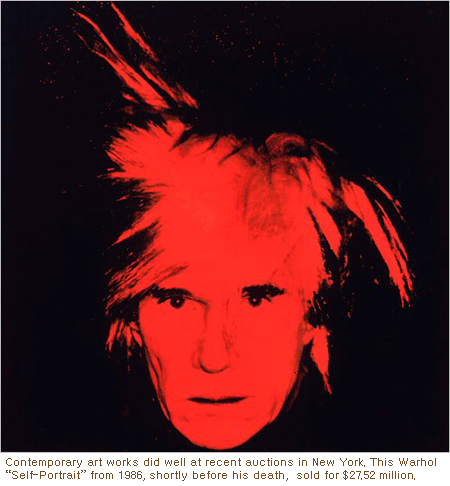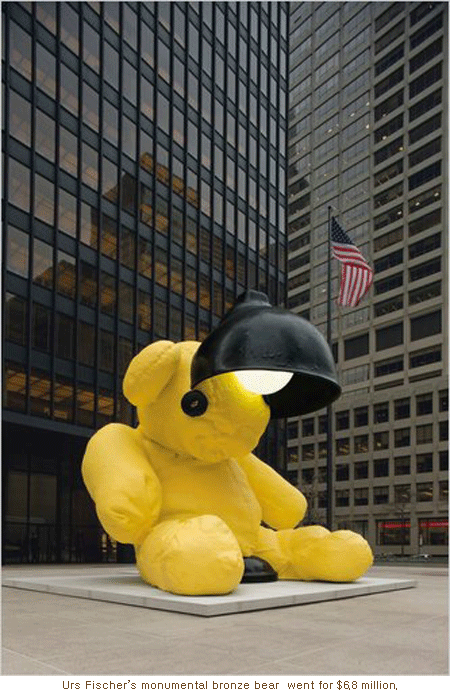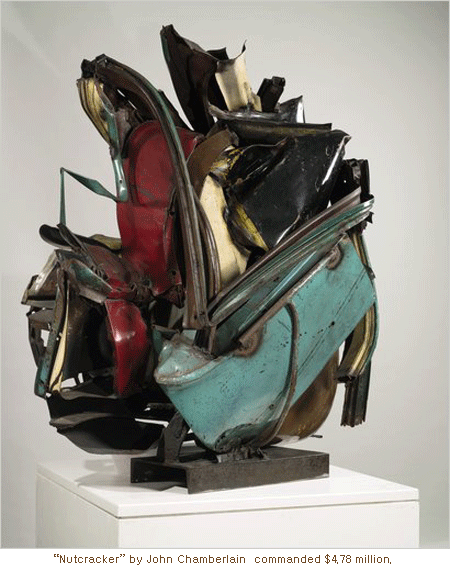In Contemporary Art Sales, Big Is Better and Famous Is Best
NEW YORK — There comes a moment in any market when prices rise so high that professionals wonder how much longer the fluke can last. There is a limit to everything, and at times this week, as the Contemporary art sales continued, that limit did not seem to be very far away.

When Sotheby’s held its Monday evening session that dealt with the collection built up by the legendary dealer Allan Stone, the room was carried away. Sotheby’s expected the 42 works of art to bring $46.8 million in the best of cases. The score was $54.8 million. Only three insignificant pieces went unsold.
In the first part of the session, works from the New York school of the 1950s to the 1970s stirred up sentimental emotions in the older generation of Contemporary art fans.
They pounced on the first lot, an “Untitled” essay in Abstract Expressionism signed by Franz Kline in 1957. The tiny piece in oil and collage on paper, only 27.9 by 21.3 centimeters, or 11 by 8 3/8 inches, shot to $446,500, more than triple the upper estimate.
Another small work of art followed, John Chamberlain’s 1961 jumble of crushed steel and torn fabric supported by a thick backing board 30.5 centimeters long. Also untitled, the work looked like a preparatory study and was treated like a master’s relic with bids rising to $662,500.
Until this week, Contemporary art had to be big and colorful to hit the roof. Not any more.
The Chamberlain study paved the way for the real thing, a big jumble of crushed steel with the paint flaking off as if Chamberlain had picked up the material on a scrap heap.
Titled “Nutcracker,” the jumble had been “executed in 1958,” the experts wrote before reeling off the list of shows that had taken it to the Cleveland Museum of Art, the Solomon R. Guggenheim Museum and elsewhere. Clearly Chamberlain’s mess of old steel was art. The “Nutcracker” more than doubled the highest expectations and became the most expensive Chamberlain ever at $4.78 million.
The second part of the Allan Stone sale focused on Wayne Thiebaud. It was described in the second volume of the catalog, which played up the “collection” theme, thus giving the paintings an additional aura of respectability. Thiebaud’s works, rarely seen at auction, sold like hot cakes.
No clear connection between style or period and the prices achieved could be detected. The evocation of the simple joys of everyday life was what mattered. “Four Pinball Machines” was a small study of 1962, only 28.3 centimeters high. It ended up at $3.44 million, more than three times the high estimate.
The highest price paid for a Thiebaud that evening, $4 million, went to another realistic picture, a 1961 still life of “Pies” done in thick impastos. Gazing at a photograph of Allan Stone installing works for the first one-man show he organized in 1962 for Thiebaud in his gallery, with “Pies” hung on the wall behind him, prospective bidders felt that a piece of cultural history was on offer.
The contrast between the elation that prevailed at the May 9 sale of Allan Stone’s collection and the dour, business-as-usual mood at Sotheby’s evening auction of Contemporary art from various owners on May 10 was startling.
Estimates had been set at a super maximum. The first three top prices were paid by bidders battling against the reserve. Rarely was the speculative character of the market more blatant.
“Pink Panther,” a porcelain figure of a woman embracing the pink feline was produced in 1988 by Jeff Koons in an edition of three plus one artist’s proof. It had been sold at a 1998 auction for $1.8 million. This week the price was $16.88 million. Sotheby’s duly noted that “one version is housed in the Museum of Modern Art, New York, and another resides in the Museum of Contemporary Art, Chicago.” Underwritten by the most famous institutions of the nation, Koons’s kitsch spoof had to be taken seriously.
The most expensive work of the day, Warhol’s “Sixteen Jackies” of 1964, also sold without much competition from the room. The price, $20.24 million, was enormous, but apparently not enough to satisfy the consignor, as the $20 million to $30 million estimate plus the sale charge of over 12 percent suggested.

At a lower financial level, several works similarly found takers below estimates set too high. Yet, that evening buyers were unquestionably bullish. There was no need for artificial prodding.
An unusual abstract picture painted by Warhol in 1978, “Shadow (Red),” more than quadrupled expectations at $4.84 million after intense competition.
Gerhard Richter’s “Abstract Picture” of 1985 made it to the high estimate and brought $2.32 million.
Price manipulation in a market that is spontaneously strong seems as absurd as it is reckless. It is the consequence of the current domination of the international auction scene by two giants who are at each other’s throats. The urge to secure an ever bigger share of a market with shrinking supplies is just too strong.
This week Christie’s came out the winner in that dangerous game. Its evening sale on May 11 was an unqualified triumph with 62 lots realizing a total of $301.68 million. Only three works on the block did not make it.
Bidders scrambled to buy everything and anything. A set of three cibachrome prints mounted on board and executed by Janine Antonini in 1994 opened the proceedings. The banality of the photographic images from an edition of 10 that were offered under the title “Mom and Dad” did not seem promising. Yet the set sold for $182,500.
Three lots down Mike Kelley’s set of eight cibachrome prints from an edition of 12, “Ahh... Youth” went up to $1.02 million, far above the high estimate. Photography triumphed when Cindy Sherman’s color coupler print of a young girl in her teens reclining on a tile floor inexplicably rose to $3.89 million, setting the first of several auction records. Executed in 1981, it is No.10 in an edition of 10, making the price stupendous. But the size, 61 by 121.9 centimeters, was large and the name is familiar. These are factors that contributed to some of the highest prices this week.
When they enhanced New York school works executed in the three decades following World War II, the sky was the limit. One of Mark Rothko’s abstract compositions where color is spread in uneven horizontal blocks soared to $33.68 million. “Untitled No.17,” previously unpublished, pitched against each other two contestants who jumped in the moment the auctioneer Christopher Burge opened the bidding at $13 million.
The next gigantic price, $27.52 million, greeted a “Self-Portrait” painted by Andy Warhol in 1986, the year preceding his death. The image, 271.2 by 270.5 centimeters, is vast.
Another large image by Warhol, a “Self Portrait” in four parts, triggered the other epic bidding match of the day. Dated 1964, it established the auction record for any Warhol self-portrait at $38.44 million.
Substance or style were clearly irrelevant this week. Size and name recognition were enough. World record prices were paid for one of Cy Twombly’s “Untitled” abstract scrolling patterns thinly painted on a solid ground ($15.2 million), but also for a monumental bronze reproduction of a teddy bear under a lamp cast in 2005-6 by Urs Fischer ($6.8 million). A very large figural view in Anselm Kiefer’s idiosyncratic manner with an Expressionist touch, “Dem unbekannten Maler” (To the Unknown Painter) brought a record $3.55 million.
In short, Christie’s performance was sensational. Sadly, it heralds risks for the future. Before opening the proceedings, Mr. Burge announced that Christie’s “guarantee of 11 lots” had “been financed in whole or in part by third parties who are bidding on these lots.” This means that Christie’s did not put excessive faith in its own estimates, with good reason. No one can say for sure how long a rhythmical scrolling pattern will continue to pass for art. Or a gigantic bronze teddy bear for that matter.


